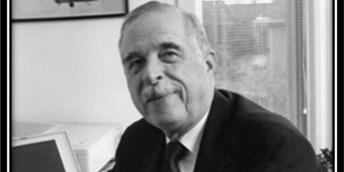The Daniel Guggenheim Medal and my son-in-law’s grandfather, Eugene Covert
Contributor: Barry Fetzer
Sources: Charleslindbergh.com, news.mit.edu
We typically focus on the famous, the in-the-news, constantly reported-on, “People Magazine-type” people when we think about or write about people. The “in the background”, back stage, supporting-cast kind of people often go unrecognized.
I have written a lot about relatives who were involved in aviation, all supporting-cast kind of people. While they were heroes to me, publicly they were nobodies. And I have plenty of these aviation relatives, perhaps the reason that I, too, became involved in aviation and have been—and still am—involved after over 50 years. Aviation blood courses through my veins.
In this pieceI am writing about my son-in-law’s maternal grandfather, Eugene Covert, about whom few have ever heard. Is my son-in-law’s grandfather even a real “relative”?
Well, in doing some research on in-law relations, I discovered that my son-in-law’s grandfather is actually my great grandfather-in-law. So, while we may not have “blood relative” aviation plasma coursing through our collective veins, I am honored to have known and to write that Eugene Covert and I are, in fact, relatives. And the Aviation Gods certainly looked down and shined on him, and to a far lesser extent me, directing us both into aeronautical careers.
Regardless of his lack of public fame, though, Eugene Covert had an outsized impact on aviation. I had the honor of meeting him only twice: at my daughter and son-in-law’s wedding rehearsal dinner in Washington, DC, and at their wedding ceremony also in Washington, DC. I had no idea when I met him that he had been awarded, arguably, aeronautics most prestigious award, the Guggenheim Medal.
Eugene Covert proved himself to be a very humble man and not one to brag. But even if he had been a braggart, it would be very uncomfortable, even for a world-class braggart and for anyone listening, for him to have introduced himself as, “Hello, I’m Eugene Covert, winner of the prestigious Guggenheim Medal.” That, he did not do. When I met him, he merely introduced himself as my soon-to-be son-in-law’s grandfather and as a “teacher in Cambridge”.
I appreciated Professor Covert’s interest in my career as a Marine Corps pilot during our discussions at the wedding rehearsal dinner and, it being my fortune to sit across from him, he eventually mentioned off the cuff that he was an aeronautical engineering professor. It was only later that I came to discover that more than merely a professor, he was the aeronautical and astronautical engineering chair at MIT and had been appointed to sit on the Rogers Commission, the Presidential investigative body for the Space Shuttle Challenger accident, seated on that panel with space and aviation notables the likes of Neil Armstrong, Sally Ride, Chuck Yeager, and theoretical physicist and Nobel Prize awardee, Dr. Richard Feynman, a team leader on the US “Manhattan Project” and one of the inventors of the atomic bomb.
And, just recently, in addition to all his other accolades, I discovered that my great grandfather-in-law, Dr. Covert, was a recipient of the Daniel Guggenheim Medal, one of the most notable American aeronautical achievements that can awarded. “The medal is considered,” according to Wikipedia, “to be one of the greatest honors that can be presented for a lifetime of work in aeronautics.”
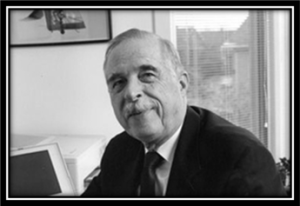
Covert in his MIT office, circa 2000. Courtesy MIT.
So how did I come to discover this amazing feat my great grandfather-in-law achieved, a secret (at least one he held from me) he took to his grave?
Just as has happened to me many times in the past, I now wish I had spent more time with him and asked him more questions. Of course, I failed to ask my own father many of the questions I now know I should have asked while he was alive, so I suppose I could be forgiven for not asking those questions to my great grandfather-in-law.
Dr. Covert is now gone, passing away ten years ago in 2015. But visiting my daughter and son-in-law’s home in Maine a couple of months ago, I noted a beautiful, wood presentation case with Dr. Covert’s name engraved on a brass placard on the lid.
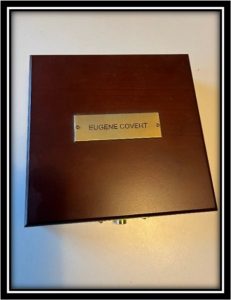

Fetzer Family photos.
After asking permission to open the lid, I was amazed to discover that it was a Daniel Guggenheim Medal, engraved with Eugene Covert’s name. If only I had known this while Dr. Covert was alive.
Based on imprecise population estimates and according to AI, billions of people have been born and have died on our little blue globe since 1929 (even AI couldn’t name a number more precise than “billions”). And from its inception in 1928 and first presentation in 1929, only 96 people (95 men and one woman) of those billions and billions of people have been presented this award. They include the likes of Orville Wright (the first recipient), William Boeing, Glenn Martin, James “Jimmy” Doolittle, Charles Lindbergh, and Igor Sikorsky, amongst other notable aviation stalwarts you’ve no doubt heard about. But most, like Dr. Covert, you haven’t heard about.
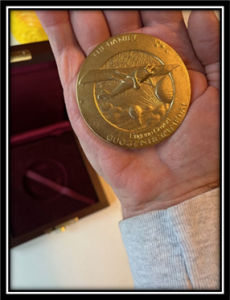
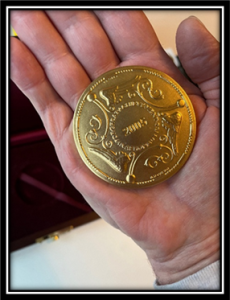
Those are my undeserving hands holding Dr. Covert’s 2005 Guggenheim Medal. Few ever get a chance to see one of these actual medals. Fewer still get a chance to hold this medal. A miniscule number of people are nominated for and awarded it as Dr. Covert was.
Fetzer Family photos.
According to one of the Medal’s sponsors, the American Institute of Aeronautics and Astronautics (AIAA), “The history of aeronautics has been the result of the foresight, courage and determination of individuals. Over the centuries, man has aspired to fly. The first successful advance toward controlled conquest of the air was in 1903 when the Wright brothers made their epochal flight at Kitty Hawk, North Carolina. By 1927, a growing number of pioneers had become outstanding in promoting the art, a war has been fought in which the new mechanisms had had their baptism in fire, a new branch of engineering and the corresponding engineering sciences had been established.
“The time had come when these pioneers merited special recognition. A group of prominent aeronautical engineers had plans for an organization which would recognize those persons who made notable achievements in the advancement of aeronautics. Daniel Guggenheim, interested by his son, Harry, who had been a naval aviator in World War I, had given $3,000,000 for the promotion of aviation, through the Daniel Guggenheim Fund for the Promotion of Aeronautics.
“The Daniel Guggenheim Medal was established as an international award for the purpose of honoring an individual who makes notable achievements in advancing the safety and practicality of aviation. The Medal recognizes contributions to aeronautical research and education, the development of commercial aircraft and equipment, and the application of aircraft to the economic and social activities of the nation. There is no restriction on account of nationality or sex.”
Interestingly and according to a website that reviews the history of Charles Lindbergh here: http://www.charleslindbergh.com/history/gugtour.asp, “Before Charles Lindbergh left for Paris on May 21, 1927, Harry Guggenheim, a North Shore multimillionaire and aviation enthusiast, visited him at Curtiss Field. ‘When you get back from your flight, look me up,’ said Guggenheim, who later admitted he didn’t think there was much chance Lindbergh would survive the trip.
“Lindbergh remembered and did call upon his return. It was the beginning of a friendship that would have a profound impact on the development of aviation in the United States. The two decided Lindbergh would make a three-month tour of the United States, paid for by a fund Harry and his father, Daniel, had set up earlier to encourage aviation-related research.
“The Daniel Guggenheim Fund sponsored Lindbergh on a three-month nation-wide tour. Flying the Spirit of St. Louis, he touched down in 48 states, visited 92 cities, gave 147 speeches, and rode 1,290 miles in parades.
“‘Lindbergh was seen by literally millions of people as he flew around the country,’ said Richard P. Hallion, historian for the Air Force and the author of a book on the Guggenheims. ‘Airmail usage exploded overnight as a result,’ and the public began to view airplanes as a viable means of travel.”
Fast forward to 1929 and the first of the Daniel Guggenheim Medals being awarded to Orville Wright.
Dr. Eugene Covert was the 80th awardee of the Medal in 2005. According to a news release from MIT on November 4, 2005 and retrieved from https://news.mit.edu/2005/covert-receive-one-aviations-highest-awards on July 5, 2025, “Covert’s aeronautics career began in 1946 at 20 years of age after graduating from the University of Minnesota at the Naval Air Modification Unit’s Pilotless Aircraft Division, where he worked on projects leading to the development of the Sparrow anti-aircraft missile. In the 1950s he conducted tests on numerous aircraft types, including the famed F-4 Phantom, at the MIT Naval Supersonic Wind Tunnel. His interest in the problems of model support led him to develop the world’s first practical wind tunnel magnetic suspension system.”
Dr. Covert’s award photo (2005), his Guggenhein Medal award citation, and his Medal certificate follow:
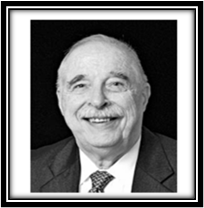
Dr. Eugene Covert (courtesy of the AIAA).
“For exemplary leadership in aeronautics teaching and research, development of significant state-of-the-art aerodynamic testing techniques, and outstanding contributions to public service. From his early work on unsteady flows, aerodynamic heating, and magnetic suspension systems for aerodynamic testing, to his high speed, high Reynolds Number investigations and contributions in the field of engine/airframe interactions, Eugene Covert has always led the way in unusual techniques and innovative solutions in aerodynamic investigations. His creative multidisciplinary approach to the analysis of aerodynamic problems is well known and has been an asset to the Nation’s aircraft programs, as well as to the students in his laboratory. Covert joined the Naval Air Development Center in 1948 as a flight test engineer after completing his Bachelors and Master’s Degrees in aeronautical engineering at the University of Minnesota. In 1952 he moved to the Massachusetts Institute of Technology (MIT) Aerophysics Laboratory as a research engineer in the Naval Supersonic Laboratory and after completing his D.Sc. at MIT was elevated to Director of the Laboratory. In 1963, he was appointed Associate Professor of Aeronautics and Astronautics at MIT and has been with MIT since that time, serving as Department Head for a period of time. He has taught numerous courses in aeronautics and conducted research related to testing at subsonic, supersonic and hypersonic speeds. In 1992 he was appointed as the inaugural holder of the T. Wilson Professor of Aeronautics Chair, and in 1996 retired as the T. Wilson Professor Emeritus. Covert has been a consultant to numerous government laboratories and industries. He has served the greater aeronautics community in many ways. In 1972 he was appointed the Chief Scientist of the U.S. Air Force, and in 1986 was named to the Presidential Commission on the Space Shuttle Challenger Accident. He was named to the U.S. Air Force Scientific Advisory Board for which he also served as Chair from 1982 to 1986. He has also served on the NASA Aeronautics Advisory Committee, the Office of Science and Technology Policy (OSTP) Aeronautical Technology Policy Review Committee, and the National Research Council Aeronautics and Space Engineering Board. Since 1994, he has been a member of the Air Force Executive Independent Review Team for the F 22 and the F-35 engine development programs.”
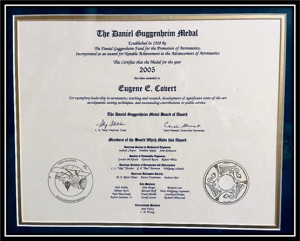
Dr. Covert’s Guggenheim Medal Certificate. Fetzer Family photo.
A very interesting historical sidenote of Dr. Covert is his relationship with theoretical physicist Dr. Richard Feynman with whom he served on the Rogers Commission. I mentioned Dr. Feynman earlier in this column. What an interesting personality (as well as a scientist) he was! In addtion to his role on the Manhatten Project during WWII and according to Wikipedia, “He is best known for his work in the path integral formulation of quantum mechanics, the theory of quantum electrodynamics, the physics of the superfluidity of supercooled liquid helium, and in particle physics, for which he proposed the parton model. For his contributions to the development of quantum electrodynamics, Feynman received the Nobel Prize in Physics in 1965 jointly with Julian Schwinger and Shin’ichirō Tomonaga.”
And Dr. Feynman obviously missed his calling as an artist, too. Some people are blessed with all the skills and abilities! But, “them’s the breaks” as we said when we were kids.
The wisdom of kids.
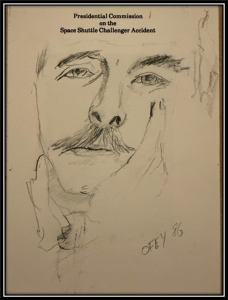
Drawing on Rogers Commission Stationary of Dr. Covert by famed theoretical physicist Richard Feynman who served on the Rogers Commission with Covert. This is a photo of the actual drawing that is now in the possession of Covert’s grandson, my son-in-law.
Fetzer family photo.
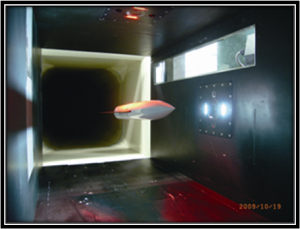
An example of magnetic suspension wind tunnel testing.
Dr. Covert was instrumental in magnetic suspension wind tunnel design. Magnetic suspension wind tunnel testing is done to “…support a model inside a wind tunnel with magnetic force, allowing users to avoid the interference that supporting devices in conventional wind tunnel testing cause. Therefore, magnetic suspension makes it possible to measure drag coefficients and wake flows for models of various configurations under ideal conditions.” Photo and above words courtesy of The Japan Aerospace Exploration Agency (JAXA) and downloaded from https://www.aero.jaxa.jp/eng//research/basic/aerodynamic/magnetic-suspension/ on July 5, 2025.
Through the research for my great grandfather-in-law’s uncommon recognition of being awarded the Daniel Guggenheim Medal, I’m grateful that I got to know him a little better. But, until Heaven sent, I’ll never know him as well as I might have should I have made the time and effort to get to know him better while he was alive. It’s yet another example of the old adage that the days are long but the years are short. Reach out. Ask questions now, while those we love are still alive, so that the details of their lives are not lost to those short years and to the dustbin of history.
A man of Dr. Covert’s caliber and abilities is rare, indeed. I hope my grandsons…my daughter and son-in-law’s boys…that count Dr. Covert as their paternal great-grandfather will someday appreciate, as I do, the notable, distinguished, and memorable role their great grandfather played in aeronautical history.

